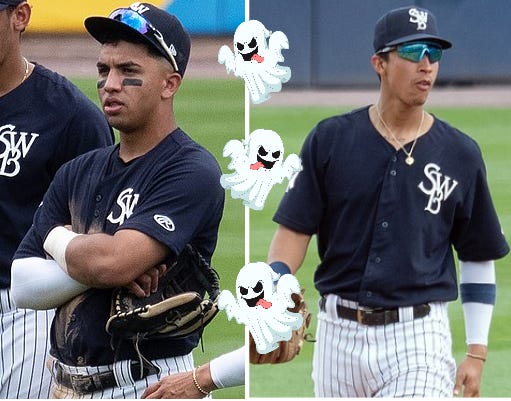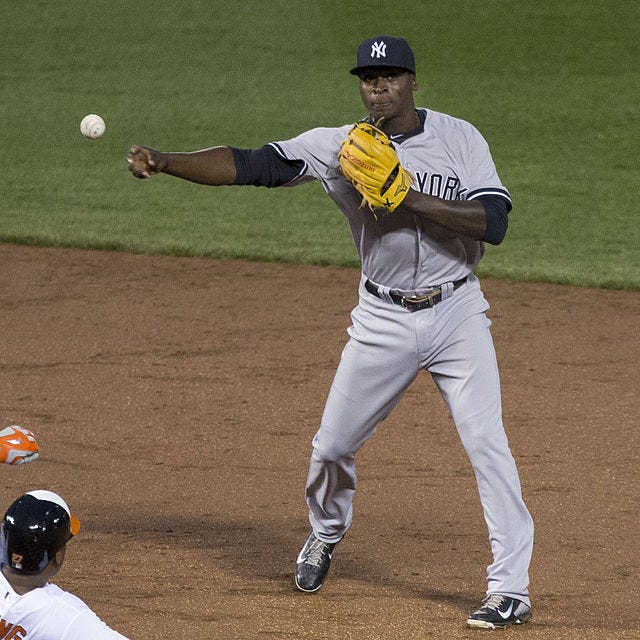Preface: I wrote this in the two weeks surrounding Opening Day last month, and have not updated it since. To a first approximation, everyone who wasn’t injured when I wrote this is now injured. The Yankees are currently 17-15.
IV.
The Yankees have tried to convince themselves that Aaron Judge is the spiritual successor to Jeter since his Rookie of the Year-winning 2017 campaign. This year, after finally signing him to a long term deal, they’ve named him captain, the first since Jeter and only the sixteenth of all time, in a transparent ploy to appease the Specter. Judge is magnificent, a generational talent in his prime, coming off one of the best seasons of all-time, full stop. He has impeccable media training and body language, and by all accounts, he’s a beloved clubhouse presence, trusted leader, and all-around great teammate. But he’s just too awkward and derpy to take up the mantle of glamorous golden boy (who’s also a bit of an asshole to everyone but in a way that makes New Yorkers love him even more). And more concretely, though he’s willing to play out of position in center (at an All-Star level, no less), he can’t play short.
Not that they need him to, exactly. For the first time in a while, the Yankees are starting the season with competent depth at shortstop. The problem now is that they have too much of it. Last year’s starter Isiah Kiner-Falefa is back, on a one-year $6 million contract that is both a rounding error on the league’s second-largest payroll and also just expensive enough to make him both difficult to trade (as all reports indicate the Yankees are desperately trying to do) and psychologically impossible to cut outright.
IKF’s return would have raised eyebrows in a vacuum; it’s completely baffling in the context of the current Yankees roster, which has him competing with no fewer than three other shortstops: Anthony Volpe, Oswaldo Cabrera, and Oswald Peraza. All three are rookies, by the current CBA’s definition at least (Peraza and Cabrera both made their debuts late last season, both were awesome), are under team control for the next six years, and have been deemed “untouchable” in trade negotiations. They are the three most promising prospects, bar none, that have come out of our farm system in the last five years. That they all arrived at the same time, in the same position, in that specific position, is the Specter’s latest, cruelest joke, and should be enough to convince any skeptics of its malevolent existence.
The easiest solution would be to slide two members of this troika into other positions. This isn’t ideal; a shortstop is a crucial defensive position, and anyone capable of playing it at a major league level, as these three can, has elite glove skills that would be partially wasted at second or third base, two positions where elite defense doesn’t matter as much. For this year’s Yankees, this concern is moot. Second and third are already over capacity as well, as Gleyber Torres, Josh Donaldson, and DJ Lemahieu will once again begin the year playing a three-person, two-chair game of musical chairs. This rotation is the continuation of the Specter’s curse from last April, forcing one of these multiple time All Stars to function as a de facto backup for his sadistic poltergeisty amusement. This trio certainly cannot accommodate a fourth middle-infielder in their delicate choreography barring a long-term injury.
In fact, it has at times seemed that a long-term injury is exactly what the Yankees front office is silently hoping will solve all their roster crunch issues this offseason. And in fairness, the injuries do always come.1 Peruse a lineup of a late August afternoon game in any of the last six Yankee seasons, when invariably the bottom three hitters are last minute additions from the double-A squad, and the entire bullpen is random guys off the street, and you’ll start to think having four too many starting-quality infielders isn’t the worst thing after all. The right injury (or three) and all of a sudden general manager Brian Cashman will look like a genius for his savvy risk management.
Of course, the Specter is too wily for that, and so this spring the Yankees have only suffered the wrong injuries. As of opening day, the injured list includes center fielder Harrison Bader, starting pitchers Luis Severino, Carlos Rodon, Luis Gil, and Frankie Montas, relievers Tommy Kahnle, Scott Effross, and Lou Trivino, and catcher Ben Rortvedt. Some of these are easily replaceable role players, while others leave gaping, existentially threatening holes. The only thing they all have in common is that none of them play a middle infield position. In terms of injuries, the Yankees are a coastal city that, having repeatedly been decimated by natural disasters, finally raised enough money to invest in critical resilience infrastructure, spent it all on a state-of-the-art seawall to mitigate damage from hurricanes, and then immediately suffered a massive earthquake instead.
V.
It would be easy to attribute the origin of Spooky Six, the appalling apparition that stalks the dirt to the northwest of second base at 161st Street and River Avenue in the Bronx, to Jeter’s departure, but it wouldn’t be quite accurate. In fact, Jeter’s first replacement, Didi Gregorius, enjoyed a serene five-year stint as the Yankees starting shortstop, and left with his mind and soul entirely intact. Plucked from the Arizona Diamondbacks system for next to nothing, Didi was exactly what the Yankees needed, a dirt-cheap youngster, utterly mediocre for now, but with intriguing upside, the exact opposite of the bloated, decrepit, outrageously expensive array of former all-stars that joined him on the 2015 squad. He understood the delicate psychic needle he had to thread between bringing a baseline level of competence to the lineup and the field, while also not shining in either area so much that fans would begin to notice that it had been at least two years since Jeter had been competent in either. The nerds noticed, of course, with Neil Paine of FiveThirtyEight.com pointing out that Didi had been worth nearly three more WAR than Jeter, the biggest year-over-year improvement any team had made at shortstop that year. But Didi struck out and booted ground balls just enough to avoid making it awkward, something Yankees fans subconsciously appreciated quite a bit.
He was a little better in 2016, and then dramatically so in 2017 and 2018, just like the rest of the team, and the fans loved him for that too. He started tweeting triumphant, if vaguely surreal strings of emojis after every win, summarizing key moments with goofy codes (no points for guessing what 👨⚖️💣 meant). These tweets helped remind fans that even when he was excellent (he always seemed to hit home runs to the second deck in right field whenever I was at the Stadium those two seasons), his purpose was to highlight his star teammates. He was never more than a role player, an attendant lord to swell a scene or two, and after an injury-hampered 2019 campaign, he was out of arbitration years, sensibly interested in signing a multiyear, eight-figure contract that the Yankees were (equally sensibly) unwilling to give him, and so he departed to the Phillies on good terms. I was sad to see him go, but the way a college freshman might be sad about the graduation of a friendly senior who was fun to chat with once a month, yet whose departure felt natural, and even necessary to make way for the growth of newer things.
In this case, the newer things took a specific form: a baby-faced Venezuelan 22 year-old, already a two-time All-Star middle infielder in as many big league seasons, with elite defensive skills, an excellent batting average, and oh yeah, 38 home runs. A few crazy reporters even tossed him MVP votes that year. Didi’s departure augured a new era in the history of superstar Yankee shortstops, one that violently awoke Spooky Six from his slumber. Gleyber Day had arrived.
Next Week in the Great Volpening: The Gley Pride Parade, The Gleyteway Drug of Juiced Balls, and A Terrible Two Years in the Gleyberhood.





